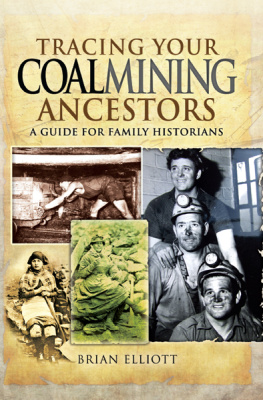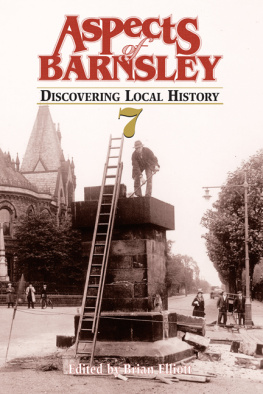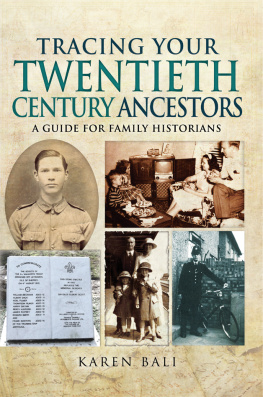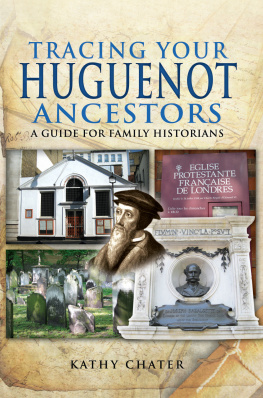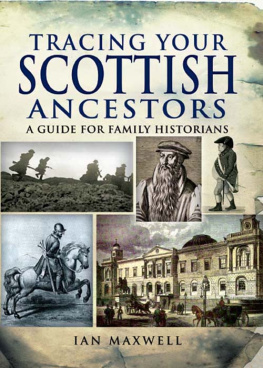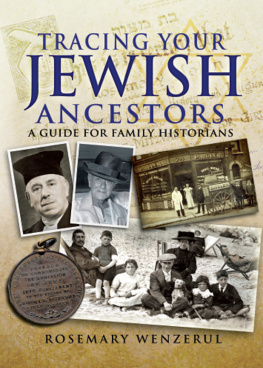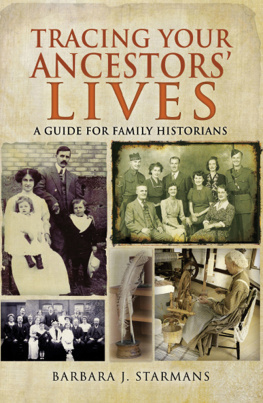
First published in Great Britain in 2014 by
PEN & SWORD FAMILY HISTORY
An imprint of
Pen & Sword Books Ltd
47 Church Street
Barnsley
South Yorkshire
S70 2AS
Copyright Brian Elliott, 2014
PAPERBACK ISBN: 978-1-84884-239-7
PDF ISBN: 978-1-47383-641-9
EPUB ISBN: 978-1-47383-465-1
PRC ISBN: 978-1-47383-553-5
The right of Brian Elliott to be identified as the author of this work has been
asserted by him in accordance with the Copyright, Designs and Patents Act 1988.
A CIP catalogue record for this book is available from the British Library.
All rights reserved. No part of this book may be reproduced or transmitted in any form
or by any means, electronic or mechanical including photocopying, recording or by any
information storage and retrieval system, without permission from the Publisher in writing.
Typeset by Concept, Huddersfield, West Yorkshire.
Printed and bound in England by CPI Group (UK) Ltd, Croydon, CR0 4YY.
Pen & Sword Books Ltd incorporates the imprints of
Pen & Sword Archaeology, Atlas, Aviation, Battleground, Discovery,
Family History, History, Maritime, Military, Naval, Politics, Railways, Select,
Social History, Transport, True Crime, Claymore Press, Frontline Books,
Leo Cooper, Praetorian Press, Remember When, Seaforth Publishing
and Wharncliffe.
For a complete list of Pen & Sword titles please contact
PEN & SWORD BOOKS LIMITED
47 Church Street, Barnsley, South Yorkshire, S70 2AS, England
E-mail:
Website: www.pen-and-sword.co.uk
CONTENTS
ACKNOWLEDGEMENTS
M any individuals and organisations deserve my thanks for their help during the course of the five years of research and writing of this book. Special thanks are due to Rupert Harding and Simon Fowler at Pen & Sword Books for their patience and support and to Susan Last for copy-editing the text. Thanks also to Ian Helliwell for typesetting and design. The curators and librarians at our three excellent national mining museums have been extremely kind and helpful. Grateful thanks are due to Ceri Thompson at the Big Pit, who has responded to numerous queries on both Welsh mining and mining in general; and also to Robert Prothero-Jones at the National Waterfront Museum. I am indebted to staff at all of the national organisations consulted for supplying and/or directing me to information, and special thanks are due to the British Librarys staff at Colindale when I was working on newspaper sources during the early stages of research. Author Geoffrey Howse deserves thanks for his kindness and hospitality when I was at work in London.
For the research section, several hundred regional librarians, information officers and archivists responded to my requests for information about mining sources via letter, telephone, email and website enquiry form; and many read and approved relevant entries, though any errors and omissions remain my own. Many thanks to them.
I am grateful to the Masters and Fellows of Trinity College, Cambridge for permission to quote from the Munby archive; and also to the Gallery of Costume, Platt Hall (Manchester City Galleries) for permission to use a Clayton image from their collection. Thanks are also due to the Big Pit/Museum of Wales for permission to use extracted material from their GLO magazine. Most of the illustrations used in this book are largely from my own picture collection unless otherwise credited. My friend, Ian Winstanley, founder of the online Coal Mining History Resource Centre, has been a constant source of support whenever needed; as have many family history societies and family historians that I have met at meetings and events over many years; indeed, several of them were even kind enough to supply case studies relating to their mining ancestors. Michelle Hassall and her son Tommie Hassall were kind enough to allow me to reproduce an extract from the award-winning essay, A day I shall never forget. Aspects of my work on military, census and other related family history information received much appreciated specialist help from Jayne Daley and Andrew and Fiona Featherstone.
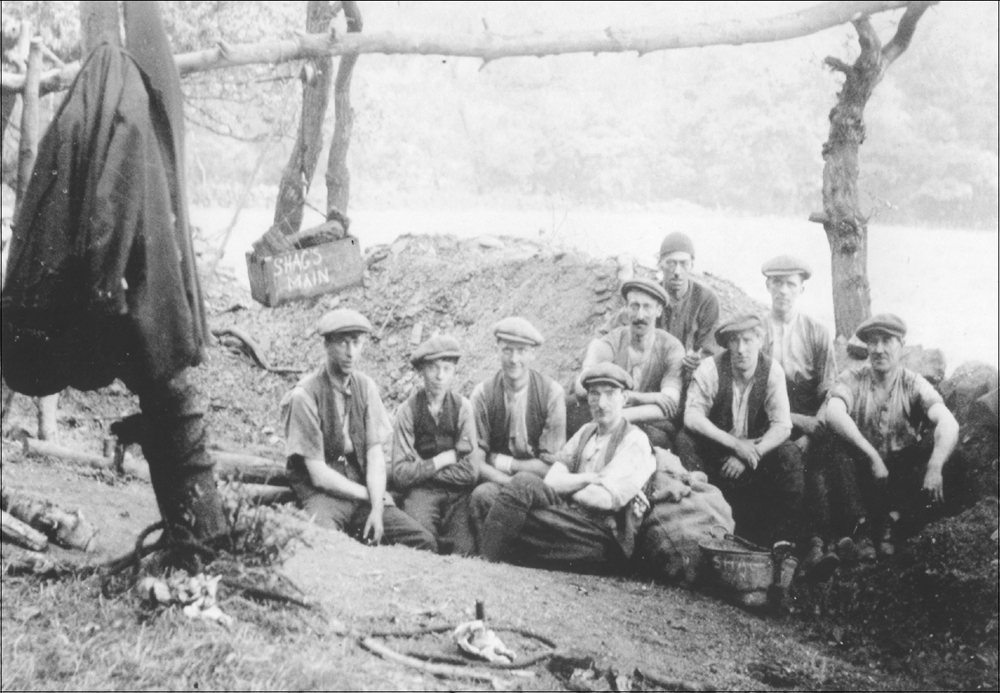
Shags Main. Impromptu outcropping such as this 1912 example was also common during subsequent strikes and lock-outs: Midhope, Sheffield.
Great thanks go out to the many miners and mining family members whom I have met and interviewed over many years. Without their help the book would not have materialised in its present form. And finally a huge thank you to my wife, Angela Elliott, for putting up with me and my seemingly never-ending shift-work in my study over such a long period of time.
A DAY I SHALL NEVER FORGET
[Extracted from an essay written in 2007 by 11-year-old Tommie Hassall after he had visited with his granddad derelict mining cottages in a former South Yorkshire pit village.]
A flat cap hung on the back of the door which led upstairs and beneath it lying on the floor was a shiny tin with a handle. Thats a snap tin, explained granddad. Is that because it snaps together? I asked. No, snap, food, thats what they put in it! For a moment I thought I could hear the sound of picks chiselling at the coal underground. I remembered watching a mineworkers procession with my mum to mark twenty years after the last miners strike. I didnt really understand then. It didnt seem dark like the mines must have been. I just remember the vibrant colour of silk banners being held by groups of men swaying in a soft light and the sound of a band. I felt I had lingered in the room too long, there was something still and private here, something intimate and alive. The soul had been ripped from the heart of the village but locked in this abandoned cottage were memories and a way of life that would remain forever. I needed to go outside and I felt I had intruded on the past. Granddad followed, we pushed the door and made it secure. The light hurt my eyes for a moment, like a miner when he first comes out from underground and I knew that I had taken something from the past with me. This was a day I would never forget.

Banners, bands and marchers during the 2004 Yorkshire miners gala that Tommie witnessed in Barnsley.
The full essay won Tommie the Simon Beaufoy [childrens] Short Story Competition, established in honour of the award-winning screenwriter, whose films include The Full Monty, Slumdog Millionaire and Salmon Fishing in the Yemen.

The onsetter signals to the winding engineman for the cage to be raised up the shaft. The miners about to ascend to light include boys barely tall enough to reach the safety bar: Denby, Derbyshire, c.1910.
GLOSSARY
Job-related |
Agent | The chief official of a large colliery or group of collieries or Group Manager after nationalisation. |
Back-overman | An Overman in charge of the back-shift of workers in a coal mine, i.e. men in charge of repair and maintenance. |
Banksman | Man employed in charge of signals and cage-loading at the top of the shaft. Collects checks from the men and liaises with the |
Next page
